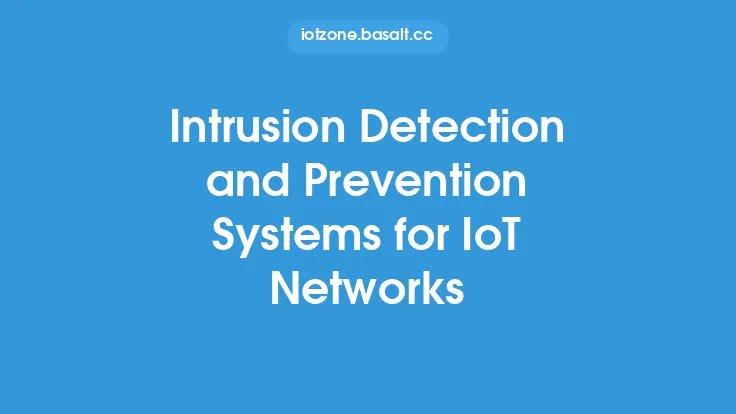The increasing number of devices connected to the internet has led to a significant rise in the potential attack surface of IoT networks. As a result, implementing robust security measures has become essential to protect these networks from unauthorized access and malicious activities. Two crucial components of IoT network security are firewalls and access controls. In this article, we will delve into the world of firewalls and access controls, exploring their importance, types, and implementation in IoT networks.
Introduction to Firewalls
A firewall is a network security system that monitors and controls incoming and outgoing network traffic based on predetermined security rules. It acts as a barrier between the IoT network and the internet, blocking malicious traffic and allowing legitimate traffic to pass through. Firewalls can be hardware-based, software-based, or a combination of both. In IoT networks, firewalls play a critical role in preventing unauthorized access, blocking malicious traffic, and protecting devices from attacks.
Types of Firewalls
There are several types of firewalls that can be used in IoT networks, including:
- Network firewalls: These firewalls are designed to protect the entire network from external threats. They are typically installed at the network perimeter and can be hardware-based or software-based.
- Host-based firewalls: These firewalls are installed on individual devices and protect them from external threats. They are typically software-based and can be configured to allow or block specific traffic.
- Application firewalls: These firewalls are designed to protect specific applications or services from external threats. They are typically software-based and can be configured to allow or block specific traffic based on the application or service.
- Next-generation firewalls: These firewalls are designed to provide advanced security features, such as intrusion prevention, malware detection, and sandboxing. They are typically hardware-based and can be configured to provide granular control over network traffic.
Access Controls
Access controls are security measures that regulate who can access the IoT network, devices, and data. They are designed to ensure that only authorized individuals or devices can access the network and its resources. Access controls can be implemented using various techniques, including:
- Authentication: This involves verifying the identity of users or devices before granting access to the network.
- Authorization: This involves determining what actions users or devices can perform on the network once they have been authenticated.
- Accounting: This involves tracking and monitoring user or device activity on the network.
Implementing Firewalls and Access Controls in IoT Networks
Implementing firewalls and access controls in IoT networks requires careful planning and configuration. Here are some best practices to follow:
- Conduct a network assessment: Before implementing firewalls and access controls, conduct a thorough assessment of the IoT network to identify potential vulnerabilities and risks.
- Choose the right firewall: Select a firewall that is suitable for the IoT network, taking into account factors such as network size, traffic volume, and security requirements.
- Configure firewall rules: Configure firewall rules to allow or block specific traffic based on the security requirements of the IoT network.
- Implement access controls: Implement access controls, such as authentication, authorization, and accounting, to regulate who can access the IoT network and its resources.
- Monitor and maintain: Continuously monitor and maintain the firewalls and access controls to ensure they are functioning correctly and effectively.
Technical Considerations
When implementing firewalls and access controls in IoT networks, there are several technical considerations to keep in mind. These include:
- Network protocols: IoT devices use a variety of network protocols, such as CoAP, MQTT, and HTTP, which must be taken into account when configuring firewalls and access controls.
- Device management: IoT devices require management and maintenance, which can be challenging when firewalls and access controls are in place. Ensure that device management traffic is allowed through the firewall and that access controls are configured to permit device management activities.
- Scalability: IoT networks can be large and complex, requiring firewalls and access controls that can scale to meet the needs of the network.
- Interoperability: IoT devices from different manufacturers may have different security requirements and protocols, requiring firewalls and access controls that can interoperable with multiple devices and systems.
Challenges and Limitations
Implementing firewalls and access controls in IoT networks can be challenging due to the unique characteristics of IoT devices and networks. Some of the challenges and limitations include:
- Resource constraints: IoT devices often have limited resources, such as memory and processing power, which can make it difficult to implement robust firewalls and access controls.
- Complexity: IoT networks can be complex and heterogeneous, making it challenging to configure and manage firewalls and access controls.
- Cost: Implementing firewalls and access controls can be costly, especially for large-scale IoT networks.
- Maintenance: Firewalls and access controls require regular maintenance and updates, which can be time-consuming and resource-intensive.
Conclusion
In conclusion, implementing firewalls and access controls is essential for securing IoT networks from unauthorized access and malicious activities. By understanding the importance of firewalls and access controls, selecting the right type of firewall, and implementing best practices, organizations can protect their IoT networks and devices from potential threats. However, implementing firewalls and access controls in IoT networks can be challenging due to the unique characteristics of IoT devices and networks. By being aware of these challenges and limitations, organizations can take steps to overcome them and ensure the security and integrity of their IoT networks.




